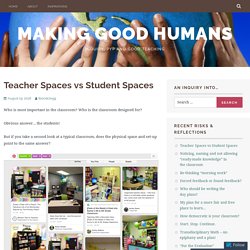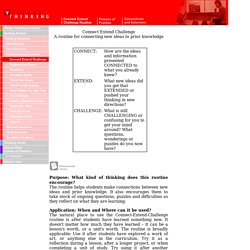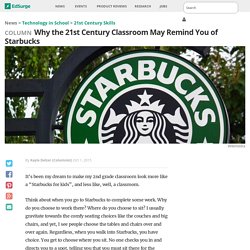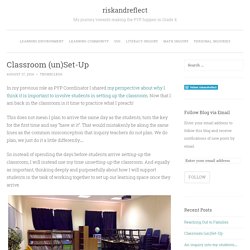

Teacher Spaces vs Student Spaces – Making Good Humans. Who is most important in the classroom?

Who is the classroom designed for? Obvious answer… the students! But if you take a second look at a typical classroom, does the physical space and set-up point to the same answer? Teachers typically have a large spacious desk with multiple drawers, many of which that lock. Do students? Teachers typically have a large, comfy, adjustable chair with wheels, Teachers often have a private, locked cabinet for their personal possessions (bags, wallets, phones etc.). Teachers typically have a personalized corner of the classroom where they post pictures of their families, friends, old classes etc. Arguably you could say that teachers spend more time in the classroom than students – that it is their home away from home and therefore they need more comfortable furniture. Visible Thinking. Purpose: What kind of thinking does this routine encourage?

The routine helps students make connections between new ideas and prior knowledge. It also encourages them to take stock of ongoing questions, puzzles and difficulties as they reflect on what they are learning. Application: When and Where can it be used? The natural place to use the Connect-Extend-Challenge routine is after students have learned something new. It doesn't matter how much they have learned – it can be a lesson's worth, or a unit's worth. A new school year: Setting up your teaching space. Dylan Meikle, a PYP workshop leader, an elementary school counselor at the Western Academy of Beijing and prior homeroom teacher In this article you will find some ideas on setting up your teaching space at the beginning of a new school year.

Busy days rearranging furniture and organizing resources characterize the buildup to a new school year. Mix in a pinch of nervous energy and a whole lot of good intention and teachers can spend dozens of hours preparing their physical space for their new class. But in all this bustle and rush, are we missing opportunities to create classrooms that will maximize teaching and learning? Prior to the first day of the year with students, most teachers rethink teaching spaces to best suit the anticipated needs of learners, their own style of teaching, and the curriculum that they will be delivering. Laura Poole (@laurajpoole) 20 January 2015 Rebecca Meilak (@TeachLearnConn) 20 January 2015 2) It’s OK to start with a blank canvas References:
Why the 21st Century Classroom May Remind You of Starbucks. It’s been my dream to make my 2nd grade classroom look more like a “Starbucks for kids”, and less like, well, a classroom.

Think about when you go to Starbucks to complete some work. Why do you choose to work there? Where do you choose to sit? I usually gravitate towards the comfy seating choices like the couches and big chairs, and yet, I see people choose the tables and chairs over and over again. Regardless, when you walk into Starbucks, you have choice. Flexible Seating and Student-Centered Classroom Redesign. I remember exactly where I was when I had a watershed moment that changed me as a teacher forever.

In fact, it inspired my EdSurge column, Why the 21st-Century Classroom May Remind You of Starbucks. I was working on my TEDx presentation at my local Starbucks and, looking around, I realized that everyone seemed to be happy, engaged in their work, and relaxed. Some people chose the traditional chairs and tables while I opted for a big, comfy chair with my MacBook on my lap. The quiet music, perfect lighting, and overall aesthetics of the coffee shop were favorable for a variety of learners. And if I wanted to switch up my seat during my stay, I was free to do just that. Problem Solvers Now = Problem Solvers Later I'm a firm believer in keeping the focus on what's really important: the students.
What the Research Says Everything I do in my classroom is based on research and best practices for kids. Simple in-class activities can boost performance. Classroom (un)Set-Up. In my previous role as PYP Coordinator I shared my perspective about why I think it is important to involve students in setting up the classroom.

Now that I am back in the classroom is it time to practice what I preach! This does not mean I plan to arrive the same day as the students, turn the key for the first time and say “have at it”. That would mistakenly be along the same lines as the common misconception that inquiry teachers do not plan. We do plan, we just do it a little differently… So instead of spending the days before students arrive setting-up the classroom, I will instead use my time unsetting-up the classroom.
This process have involved three simple steps: Purge. The first thing I did was go through EVERYTHING. Then, I sorted things into piles in different areas of the classroom. I temporarily tucked away the desks and chairs… I put all the books in one place…